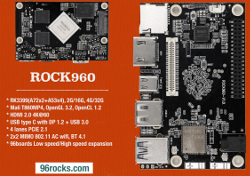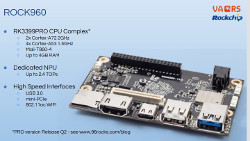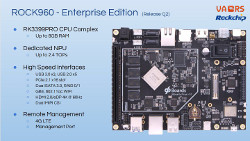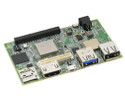96Boards.org spins AI format tapped by new Arrow, HiSilicon, Rockchip, and Avnet SBCs
Mar 19, 2018 — by Eric Brown 2,644 views [Updated: Mar. 20] — Linaro and 96Boards.org unveiled a “96Boards.ai” initiative along with several Linux-based hacker boards that comply with it: Arrow’s DragonBoard 820C, HiSilicon’s Hikey970, Rockchip’s Rock960 and Rock960 EE, Avnet’s Ultra96, and an upcoming Socionext board.
[Updated: Mar. 20] — Linaro and 96Boards.org unveiled a “96Boards.ai” initiative along with several Linux-based hacker boards that comply with it: Arrow’s DragonBoard 820C, HiSilicon’s Hikey970, Rockchip’s Rock960 and Rock960 EE, Avnet’s Ultra96, and an upcoming Socionext board.
At Linaro Connect in Hong Kong, Linaro announced yet another variation on its open source 96Boards spec called 96Boards.ai. The Linux-supported platform is designed for open source, Arm-based SBCs with “high performance real-time computer vision and intelligent audio processing, supported by machine learning algorithms and deep learning technology,” says Linaro.

DragonBoard 820c
96Boards.ai, which has not yet been documented on the 96Boards Specifications page, does not appear to a hardware spec, but rather a standard way for Linux and Android neural networking software to access the various AI goodies in selected high-end Arm SoCs. In fact, all of the announced boards, some of which have been previously revealed, use use the existing 96Boards Consumer Edition (CE) or Extended Edition (EE) hardware specs.
The three boards showcased on the 96Boards.ai product page are Avnet’s Ultra96 (Xilinx Zynq UltraScale+ MPSoC), the HiSilicon backed Hikey970 (HiSilicon Kirin 970) from Hoperun or LeMaker, and Rockchip’s previously announced Rock960, which will be updated to a new AI-enhanced Rockchip RK3399Pro SoC. Not yet on the page, but covered below, is an upcoming RockPro96 Enterprise Edition model that uses the larger EE spec. Meanwhile, Arrow’s recently announced DragonBoard 820c, which uses a new, embedded focused Qualcomm Snapdragon 820E SoC, will soon qualify as a 96Boards.ai board, followed by an upcoming board from Socionext.

Rock960
(click image to enlarge)
The 96Boards.ai products “offer different combinations of CPU, GPU, NPU, DSP and FPGA with both on-die and independent acceleration supporting hard-coded, optimized performance as well as programmable flexibility,” says Linaro. “Linaro is planning a collaborative AI software project to interface industry standard AI platforms and libraries to the multiple hardware IP solutions being offered by industry leading vendors. The goal is to accelerate innovation by removing the need for redundant and fragmented engineering effort on each proprietary solution.”
— ADVERTISEMENT —
Backed by Arm and its major licensees, Linaro develops standardized Linux- and Android embedded code and libraries, in addition to running the 96Boards open hardware community. Rockchip recently joined Linaro’s 96Boards steering committee, which already includes HiSilicon, Qualcomm, Socionext, Xilinx, and others.
Here we take a quick look at the new boards, a few of which appear to be close to opening for pre-orders. We will follow up on most of these boards with more complete reports in the coming days or weeks.
DragonBoard 820c
Arrow’s DragonBoard 820c, which follows the 96Boards Consumer Edition (CE) DragonBoard 410C, uses the larger Extended (100 x 85mm) version of the CE spec. This adds a second 60-pin high-speed connector and an audio header to the usual 40-pin low-speed and 60-pin high-speed connectors.


DragonBoard 820c, front and back
(click images to enlarge)
The DragonBoard 820c runs Debian Linux on the Snapdragon 820E, a new long lifecycle variant of the quad-core, up to 2.35GHz Snapdragon 820. Later this year, Qualcomm will extend support for its Linux-driven Snapdragon Neural Processing Engine SDK to the SBC.
Standout features include GbE, WiF-ac, BT 4.1, and 3G LPDDR4. You also get dual USB, 4K@60 HDMI, onboard sensors, and much more.

DragonBoard 820c block diagram
(click image to enlarge)
More information on the DragonBoard 820c may be found on this 96Boards page, which offers a broken link to an Arrow shopping page where you will be able to buy the board for $199. We’ll be back soon with a more complete report on the DragonBoard 820c.
HiKey970
Backed by HiSilicon, the HiKey970 will be sold by both Hoperun and LeMaker, and will focus on deep learning, smart city, robotics, and automotive applications. Like the DragonBoard 820c, the HiKey970 adopts the 100 x 85mm Extended version of the 96Boards CE spec.
Hikey970 (left) and as seen in Charbox video from Linaro Connect
(click images to enlarge)
The Hikey970, which follows the flagship 96Boards HiKey960 and the subsequent V2 model, runs Ubuntu, Debian, or Android Master on the 10nm fabricated Kirin 970 from HiSilicon, the chip -making subsidiary of Huawei.
Available on Huawei’s Mate 10 Pro phone, the Kirin 970 has 4x Cortex-A73 cores up to 2.36 GHz, 4x 1.8GHz -A53 cores, and a top-of-the-line Arm Mali -G72 MP12 GPU. More significantly, it features a neural-network processing unit (NPU) claimed to offer 256MAC/cycles @ 960MHz.
The Kirin 970 and HiKey970 board support Huawei’s HiAI framework, which can run AI calculations on the SoC’s CPU, GPU, and NPU, as well as other neural network frameworks. In a Charbox YouTube video from Linaro Connect (see below), a HiSilicon exec says the company plans to open source HiAI.
The Charbox video shows the exec demonstrating the board and features including 2x USB host, 2x USB Type-C, HDMI, and GbE ports. There’s also a microSD slot, WiFi, and a mini-PCIe slot that supports SSDs.
The limited specs posted on the HiKey970 96Boards page separates features into robot, automobile, and smart city platforms. It’s unclear if the board will be sold in separate versions, or the more likely probability that the specs were broken up this way to show key attributes for each application. The video mentions only one board and $299 price, however
The smart city platform lists 6GB DDR4x RAM, 64GB UFS storage, 4- and 2-lane MIPI-CSI, and HDMI with H.265 at up to 3840 x 2160 @ 30fps. You also get GPS, GLONASS, and BeiDou, as well as the aforementioned GbE port.
The automotive platform replicates mention of the DDR4, CSI, and GPS functionality, and notes the availability of PCIe Gen2 x2 and CAN 2.0B up to 1Mbps. The robot platform mentions only the CAN, CSI, and 4K resolution.
Rock960 and Rock960 EE
At Linaro Connect, Rockchip’s 96rocks community announced that Rockchip’s new AI-infused Rockchip RK3399Pro SoC will appear in two new 96Boards.ai boards: the previously announced CE standard Rock960 and a larger new 96Boards Enterprise Edition (EE) Rock960 Enterprise Edition, also referred to as “Ficus.” Both boards are expected to ship in the second quarter. There was no indication whether pre-orders would open before that.


Rock960 SBC
(click images to enlarge)
The CE version of the Rock960, which was previously announced as offering an RK3399, will back up the new Pro version of the SoC with 2GB or 4GB RAM. It also provides 16GB or 32GB eMMC, a microSD slot, 802.11ac 2×2 MIMO, Bluetooth 4.1 BLE, and antenna connectors.
The Rock960 will also include single HDMI 2.0, DisplayPort, USB 2.0 host, USB 3.0 host, and USB 3.0 Type-C ports. An M.2 M-key PCIe connector is available for expansion beyond the standard 40- and 60-pin connectors, and there’s an 8-18V DC input.
96rocks had less to say about the Rock960 Enterprise Edition, which uses the same 160 x 120mm EE spec used by the LeMaker Cello. 96Boards EE has the same, backward compatible low-speed 40-pin connector as CE, but omits the MIPI-DSI and -CSI-ready high-speed 60-pin link. Unlike CE, there’s no requirement for a micro-OTG port or wireless radio, but the spec supports a PCIe x16 slot and an Ethernet port.


Rock960 (left and Rock960 EE (note that 8GB in EE slide should be 4GB)
(click images to enlarge)
The Rock960 EE offers only 4GB of RAM, not the 8GB shown in the slide above, which 96rocks says was in error. The board will offer 8x USB ports, 3x of which are 3.0, as well as the PCIe x16 slot, a GbE port, WiFi-ac, HDMI 2.0, and dual SATA 3.0 ports. The board also adds a dual MIPI-CSI camera interface.
More information on on the CE version of the Rock960 may be found at the 96Boards.ai page and 96rocks.com site.
Ultra96
Avnet’s Ultra96 (AES-ULTRA96-G) is a standard, 85 x 54mm 96Boards CE SBC with 40- and 60-pin connectors. The SBC runs Xilinx PetaLinux on Xilinx’s Zynq UltraScale+ MPSoC (type ZU3EG A484).


Avnet Ultra96 (left) and block diagram
(click images to enlarge)
Designed for machine learning, automotive, and industrial IoT, the Ultra96 is supported by Avnet’s Zedboard.org community for Avnet ARM/FPGA hybrid boards such as the MicroZed and MiniZed. The Zynq UltraScale+ MPSoC has four Cortex-A53 cores, an FPGA with 914K logic cells, a Mali-400MP GPU, and two Cortex-R5 MCUs.
The Ultra96 is equipped with 2GB of LPDDR4 and a microSD slot with a 16GB card loaded with PetaLinux. The board offers WiFi, Bluetooth 4.2, and a mini-DisplayPort. Other features include 2x USB 3.0 and 1x USB 2.0 host ports and a micro-USB 3.0 port.
More information may be found on the Ultra96 96Boards page. Avnet also has an Ultra96 shopping page, but all you can do there is request a quote.
 Fujitsu F-Cue |
Socionext board
There were no details on the upcoming Socionext board, which is said to be under development in an “S3 Project.” Socionext’s quad-core, Cortex -A15 and -A7 based MB86S71 SoC drives Fujitsu’s 96Boards CE compatible F-Cue SBC, a board that was never officially blessed by 96Boards.org.


Gigabyte’s Edge Server SynQuacer (left) and its Socionext SynQuacer 96Boards SBC
(click images to enlarge)
Last September, Socionext joined with Linaro and Gigabyte to announce a Gigabyte SynQuacer micro-server IoT gateway, also called the Edge Server SynQuacer computer. The system runs Linaro Linux on a Socionext “SynQuacer 96Boards” SBC equipped with the company’s 24-core, Cortex-A53 based SynQuacer SC2A11 SoC.


SynQuacer 96Boards SBC detail view (left) and SynQuacer SC2A11 SoC block diagram
(click images to enlarge)
It’s unclear if the board is the same as the 96Boards.ai offering, or if Socionext is working on a different solution. No timetable was offered for the arrival of the new SBC.
Further information
More information on the 96Boards.ai platform may be found in Linaro’s 96Boards.ai announcement and product page. More on the 96Boards.ai boards may be found in the various links farther above.

Please comment here...